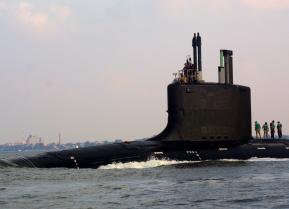The Navy's Most Dangerous Nuclear Attack Submarine Could Be the Ultimate 'Spy'
The Navy is expanding its attack submarine strategy to further emphasize enhanced “spy” like intelligence, surveillance reconnaissance missions to quietly patrol shallow waters near enemy coastline - scanning for enemy submarines, surface ships and coastal threats.
While firepower and attack weapons are naturally still a major area of focus for Virginia-Class submarines, the expanding ISR mission scope made possible by new technologies has provided key inspiration for senior Navy developers and members of Congress who have been working vigorously to increase the size of the attack submarine fleet.
The Navy is expanding its attack submarine strategy to further emphasize enhanced “spy” like intelligence, surveillance reconnaissance missions to quietly patrol shallow waters near enemy coastline - scanning for enemy submarines, surface ships and coastal threats.
Improved undersea navigation and detection technology, using new sonar, increased computer automation and artificial intelligence, enable quieter, faster movements in littoral waters where enemy mines, small boats and other threatening assets often operate.
Virginia-Class submarines are engineered with a “Fly-by-Wire” capability which allows the ship to quietly linger in shallow waters without having to surface or have each small move controlled by a human operator.
(This first appeared last month.)
With “Fly-by-Wire” technology, a human operator will order depth and speed, allowing software to direct the movement of the planes and rudder to maintain course and depth, Navy program managers have told Warrior Maven. The ships can be driven primarily through software code and electronics, thus freeing up time and energy for an operator who does not need to manually control each small maneuver. Previous Los Angeles-Class submarines rely upon manual, hydraulic controls.
This technology, using upgradable software and fast-growing AI applications, widens the mission envelope for the attack submarines by vastly expanding their ISR potential. Using real-time analytics and an instant ability to draw upon an organize vast data-bases of information and sensor input, computer algorithms can now perform a range of procedural functions historically performed by humans. This can increase speed of maneuverability and an attack submarine's ability to quickly shift course, change speed or alter depth positioning when faced with attacks.
A closer-in or littoral undersea advantage, Navy strategy documents explain, can increase “ashore attack” mission potential along with ISR-empowered anti-submarine and anti-surface warfare operations.
The US Navy’s published “Commander’s Intent for the United States Submarine Force,” published earlier this year, writes - “We are uniquely capable of, and often best employed in, stealthy, clandestine and independent operations……. we exploit the advantages of undersea concealment which allow us to: , Conduct undetected operations such as strategic deterrent patrols, intelligence collection, Special Operations Forces support, non-provocative transits, and repositioning,” the Navy strategy document writes.
The Navy is implementing elements of this strategy with its recently launched USS South Dakota, a Block III Virginia-Class attack submarine engineered with a host of new, unprecedented undersea technologies, Navy officials said.
Many of these innovations, which have been underway and tested as prototypes for many years, are now operational as the USS South Dakota enters service; service technology developers have, in a general way, said the advances in undersea technologies built, integrated, tested and now operational on the South Dakota include quieting technologies for the engine room to make the submarine harder to detect, a new large vertical array and additional "quieting" coating materials for the hull, Navy officials have told Warrior Maven.
While firepower and attack weapons are naturally still a major area of focus for Virginia-Class submarines, the expanding ISR mission scope made possible by new technologies has provided key inspiration for senior Navy developers and members of Congress who have been working vigorously to increase the size of the attack submarine fleet.
Recommended: Air War: Stealth F-22 Raptor vs. F-14 Tomcat (That Iran Still Flies)
Recommended: A New Report Reveals Why There Won't Be Any 'New' F-22 Raptors
Recommended: How an ‘Old’ F-15 Might Kill Russia’s New Stealth Fighter
Land weapons, port activities and other enemy movements in coastal or island areas are more difficult for deeper draft surface ships to access, often complicating surveillance missions – without giving away their position. Surface ships and the drones or aircraft they operate could, in a variety of operational environments, be more “detectable” to enemy radar and sensors when compared to attack submarines.
“The most important feature for maneuvering in littoral waters is the fly-by-wire control system, whereby computers in the control center electronically adjust the submarine's control surfaces, a significant improvement from the hydraulic systems used in the Los Angeles-class,” a 2016 Stanford University “The Future of Nuclear Submarines” paper by Alexander Yachanin writes.
Next-generation sonar technology, woven into Virginia-Class subs, is engineered to work in tandem with “Fly-by-Wire” technology to better identify threats operating at various depths and speed.
The Block III Virginia-Class submarines also have what’s called a Large Aperture Bow conformal array sonar system – designed to send out an acoustic ping, analyze the return signal, and provide the location and possible contours of enemy ships, submarines and other threats.
This first appeared in Warrior Maven here.


